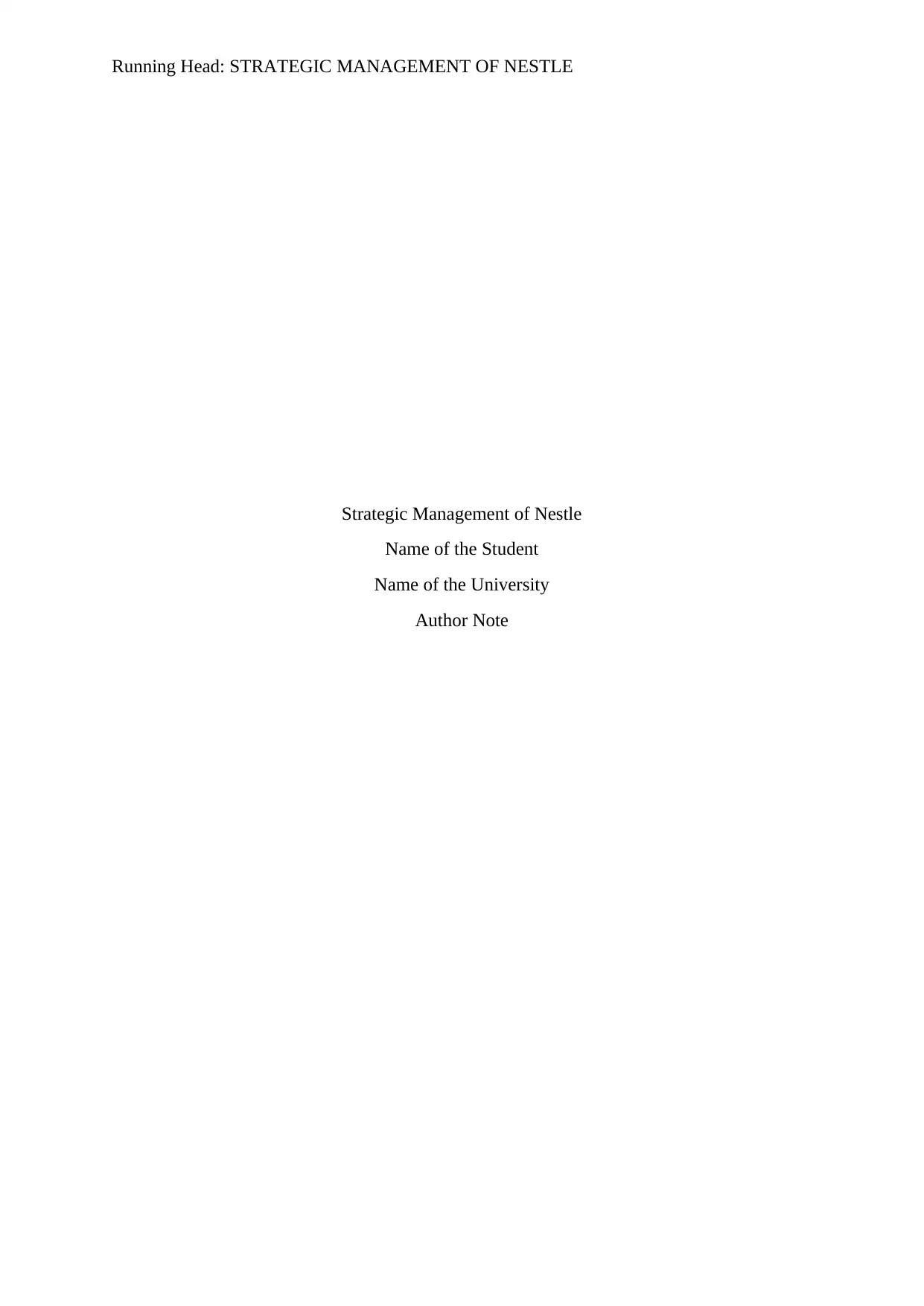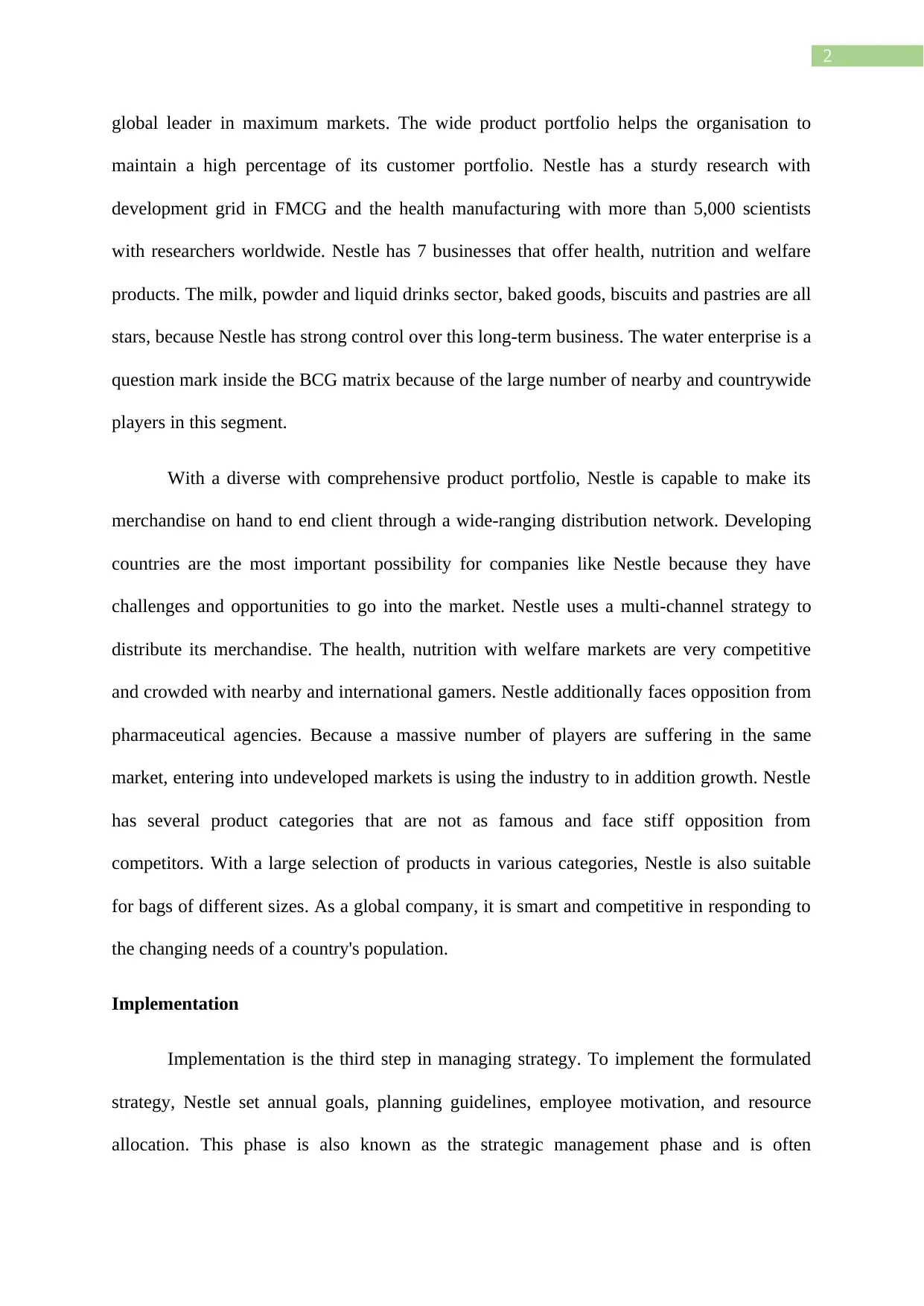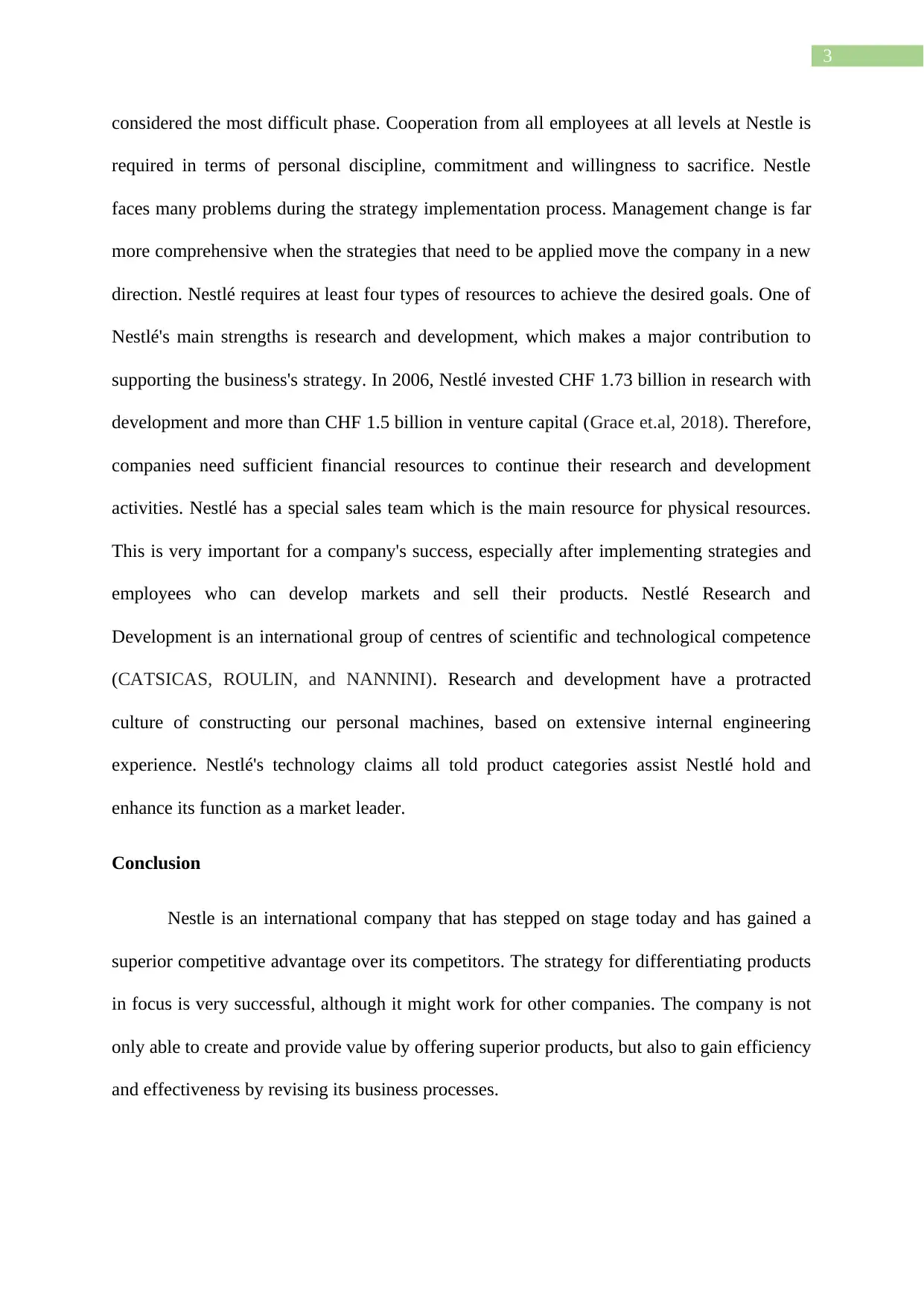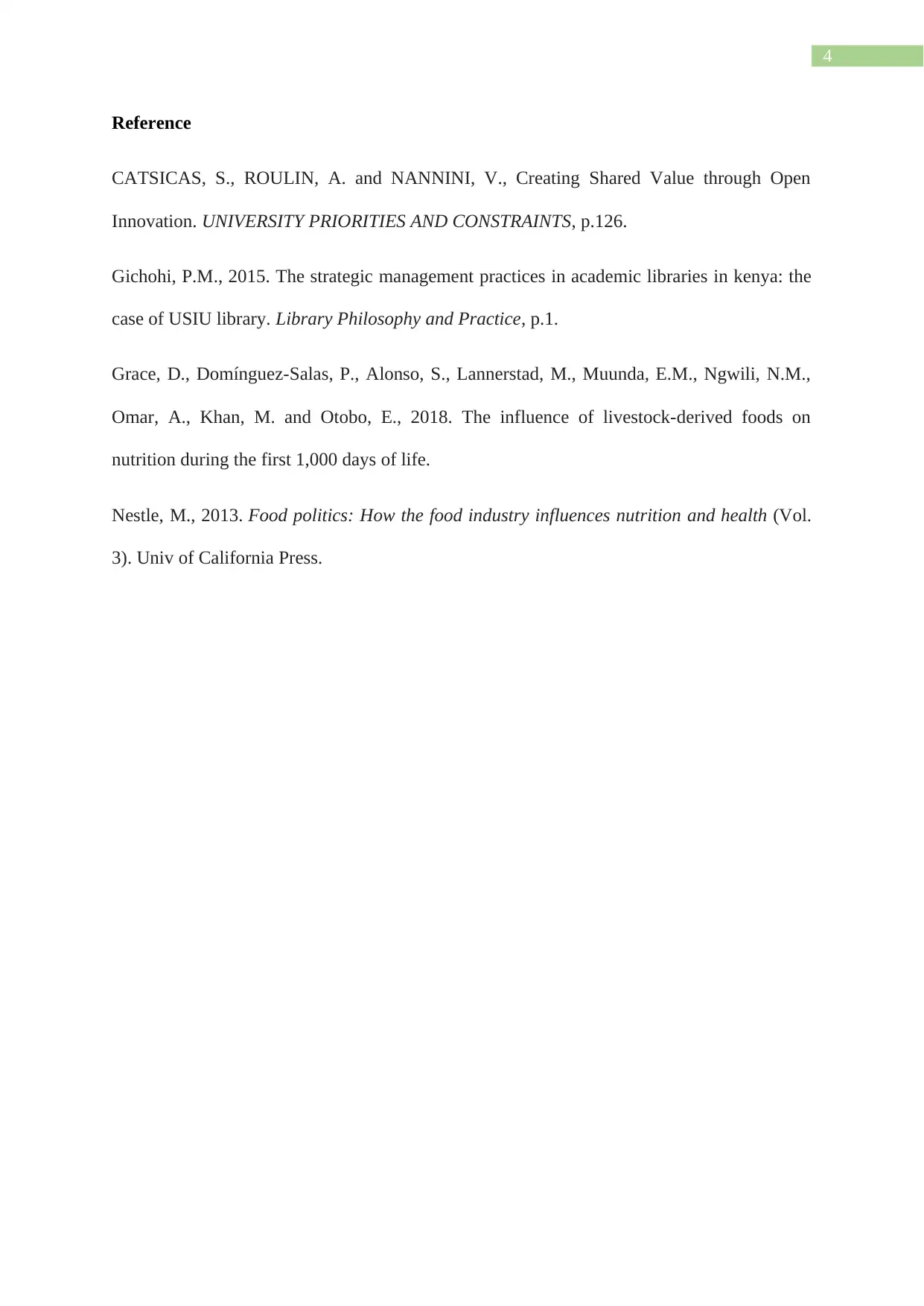Strategic Management of Nestle Brand
VerifiedAdded on 2022/08/12
|5
|1131
|23
AI Summary
Contribute Materials
Your contribution can guide someone’s learning journey. Share your
documents today.

Running Head: STRATEGIC MANAGEMENT OF NESTLE
Strategic Management of Nestle
Name of the Student
Name of the University
Author Note
Strategic Management of Nestle
Name of the Student
Name of the University
Author Note
Secure Best Marks with AI Grader
Need help grading? Try our AI Grader for instant feedback on your assignments.

1
Introduction
Nestle company is a swiss based multinational foods and drinks processing
organisation conglomerate corporation which headquarter is in Vevey, Vaud, Switzerland.
Nestle has served this world for more than one hundred and thirty years. This has
distinguished itself with a mix of high-quality products and has positioned itself as a fitness
and nutrition company, while targeting healthy people around the world. Nestle products
include toddler food, clinical food, mineral water, cereals, coffee and tea, pastries, dairy
products, ice cream, frozen foods, pet meals and snacks. This report is about how a company
uses strategic planning and implemented it.
Strategy Formulation
The aim of Nestle is to become a frontrunner in fitness and nutrition, as well as the
economic results industry, and to trust everyone involved. Nestle's undertaking for accurate
food and a very good lifestyles is to provide purchasers with the fine taste, the most nutritious
selections in various meals and beverage categories and meals events, and to emphasize that
leadership is not pretty much size. It's also approximately the behavior and consider that has
been obtained through consistent promises over a protracted period of time. And the vision,
whether for comfort, health or pleasure, is to create reliable products, systems and services
that help improve the quality of life for consumers. It makes uses of demographic,
geographical and behavioral segmentation strategies to meet the changing needs of the
maximum competitive industries. It makes uses of a combination of fee and product
positioning techniques, relying on the type of product they’re branded in and the market in
which they sell that product.
Presence in more than 190 countries helps companies with an intercultural presence
and understanding of desire. With a wide-ranging portfolio of brands, the organisation is a
Introduction
Nestle company is a swiss based multinational foods and drinks processing
organisation conglomerate corporation which headquarter is in Vevey, Vaud, Switzerland.
Nestle has served this world for more than one hundred and thirty years. This has
distinguished itself with a mix of high-quality products and has positioned itself as a fitness
and nutrition company, while targeting healthy people around the world. Nestle products
include toddler food, clinical food, mineral water, cereals, coffee and tea, pastries, dairy
products, ice cream, frozen foods, pet meals and snacks. This report is about how a company
uses strategic planning and implemented it.
Strategy Formulation
The aim of Nestle is to become a frontrunner in fitness and nutrition, as well as the
economic results industry, and to trust everyone involved. Nestle's undertaking for accurate
food and a very good lifestyles is to provide purchasers with the fine taste, the most nutritious
selections in various meals and beverage categories and meals events, and to emphasize that
leadership is not pretty much size. It's also approximately the behavior and consider that has
been obtained through consistent promises over a protracted period of time. And the vision,
whether for comfort, health or pleasure, is to create reliable products, systems and services
that help improve the quality of life for consumers. It makes uses of demographic,
geographical and behavioral segmentation strategies to meet the changing needs of the
maximum competitive industries. It makes uses of a combination of fee and product
positioning techniques, relying on the type of product they’re branded in and the market in
which they sell that product.
Presence in more than 190 countries helps companies with an intercultural presence
and understanding of desire. With a wide-ranging portfolio of brands, the organisation is a

2
global leader in maximum markets. The wide product portfolio helps the organisation to
maintain a high percentage of its customer portfolio. Nestle has a sturdy research with
development grid in FMCG and the health manufacturing with more than 5,000 scientists
with researchers worldwide. Nestle has 7 businesses that offer health, nutrition and welfare
products. The milk, powder and liquid drinks sector, baked goods, biscuits and pastries are all
stars, because Nestle has strong control over this long-term business. The water enterprise is a
question mark inside the BCG matrix because of the large number of nearby and countrywide
players in this segment.
With a diverse with comprehensive product portfolio, Nestle is capable to make its
merchandise on hand to end client through a wide-ranging distribution network. Developing
countries are the most important possibility for companies like Nestle because they have
challenges and opportunities to go into the market. Nestle uses a multi-channel strategy to
distribute its merchandise. The health, nutrition with welfare markets are very competitive
and crowded with nearby and international gamers. Nestle additionally faces opposition from
pharmaceutical agencies. Because a massive number of players are suffering in the same
market, entering into undeveloped markets is using the industry to in addition growth. Nestle
has several product categories that are not as famous and face stiff opposition from
competitors. With a large selection of products in various categories, Nestle is also suitable
for bags of different sizes. As a global company, it is smart and competitive in responding to
the changing needs of a country's population.
Implementation
Implementation is the third step in managing strategy. To implement the formulated
strategy, Nestle set annual goals, planning guidelines, employee motivation, and resource
allocation. This phase is also known as the strategic management phase and is often
global leader in maximum markets. The wide product portfolio helps the organisation to
maintain a high percentage of its customer portfolio. Nestle has a sturdy research with
development grid in FMCG and the health manufacturing with more than 5,000 scientists
with researchers worldwide. Nestle has 7 businesses that offer health, nutrition and welfare
products. The milk, powder and liquid drinks sector, baked goods, biscuits and pastries are all
stars, because Nestle has strong control over this long-term business. The water enterprise is a
question mark inside the BCG matrix because of the large number of nearby and countrywide
players in this segment.
With a diverse with comprehensive product portfolio, Nestle is capable to make its
merchandise on hand to end client through a wide-ranging distribution network. Developing
countries are the most important possibility for companies like Nestle because they have
challenges and opportunities to go into the market. Nestle uses a multi-channel strategy to
distribute its merchandise. The health, nutrition with welfare markets are very competitive
and crowded with nearby and international gamers. Nestle additionally faces opposition from
pharmaceutical agencies. Because a massive number of players are suffering in the same
market, entering into undeveloped markets is using the industry to in addition growth. Nestle
has several product categories that are not as famous and face stiff opposition from
competitors. With a large selection of products in various categories, Nestle is also suitable
for bags of different sizes. As a global company, it is smart and competitive in responding to
the changing needs of a country's population.
Implementation
Implementation is the third step in managing strategy. To implement the formulated
strategy, Nestle set annual goals, planning guidelines, employee motivation, and resource
allocation. This phase is also known as the strategic management phase and is often

3
considered the most difficult phase. Cooperation from all employees at all levels at Nestle is
required in terms of personal discipline, commitment and willingness to sacrifice. Nestle
faces many problems during the strategy implementation process. Management change is far
more comprehensive when the strategies that need to be applied move the company in a new
direction. Nestlé requires at least four types of resources to achieve the desired goals. One of
Nestlé's main strengths is research and development, which makes a major contribution to
supporting the business's strategy. In 2006, Nestlé invested CHF 1.73 billion in research with
development and more than CHF 1.5 billion in venture capital (Grace et.al, 2018). Therefore,
companies need sufficient financial resources to continue their research and development
activities. Nestlé has a special sales team which is the main resource for physical resources.
This is very important for a company's success, especially after implementing strategies and
employees who can develop markets and sell their products. Nestlé Research and
Development is an international group of centres of scientific and technological competence
(CATSICAS, ROULIN, and NANNINI). Research and development have a protracted
culture of constructing our personal machines, based on extensive internal engineering
experience. Nestlé's technology claims all told product categories assist Nestlé hold and
enhance its function as a market leader.
Conclusion
Nestle is an international company that has stepped on stage today and has gained a
superior competitive advantage over its competitors. The strategy for differentiating products
in focus is very successful, although it might work for other companies. The company is not
only able to create and provide value by offering superior products, but also to gain efficiency
and effectiveness by revising its business processes.
considered the most difficult phase. Cooperation from all employees at all levels at Nestle is
required in terms of personal discipline, commitment and willingness to sacrifice. Nestle
faces many problems during the strategy implementation process. Management change is far
more comprehensive when the strategies that need to be applied move the company in a new
direction. Nestlé requires at least four types of resources to achieve the desired goals. One of
Nestlé's main strengths is research and development, which makes a major contribution to
supporting the business's strategy. In 2006, Nestlé invested CHF 1.73 billion in research with
development and more than CHF 1.5 billion in venture capital (Grace et.al, 2018). Therefore,
companies need sufficient financial resources to continue their research and development
activities. Nestlé has a special sales team which is the main resource for physical resources.
This is very important for a company's success, especially after implementing strategies and
employees who can develop markets and sell their products. Nestlé Research and
Development is an international group of centres of scientific and technological competence
(CATSICAS, ROULIN, and NANNINI). Research and development have a protracted
culture of constructing our personal machines, based on extensive internal engineering
experience. Nestlé's technology claims all told product categories assist Nestlé hold and
enhance its function as a market leader.
Conclusion
Nestle is an international company that has stepped on stage today and has gained a
superior competitive advantage over its competitors. The strategy for differentiating products
in focus is very successful, although it might work for other companies. The company is not
only able to create and provide value by offering superior products, but also to gain efficiency
and effectiveness by revising its business processes.
Secure Best Marks with AI Grader
Need help grading? Try our AI Grader for instant feedback on your assignments.

4
Reference
CATSICAS, S., ROULIN, A. and NANNINI, V., Creating Shared Value through Open
Innovation. UNIVERSITY PRIORITIES AND CONSTRAINTS, p.126.
Gichohi, P.M., 2015. The strategic management practices in academic libraries in kenya: the
case of USIU library. Library Philosophy and Practice, p.1.
Grace, D., Domínguez-Salas, P., Alonso, S., Lannerstad, M., Muunda, E.M., Ngwili, N.M.,
Omar, A., Khan, M. and Otobo, E., 2018. The influence of livestock-derived foods on
nutrition during the first 1,000 days of life.
Nestle, M., 2013. Food politics: How the food industry influences nutrition and health (Vol.
3). Univ of California Press.
Reference
CATSICAS, S., ROULIN, A. and NANNINI, V., Creating Shared Value through Open
Innovation. UNIVERSITY PRIORITIES AND CONSTRAINTS, p.126.
Gichohi, P.M., 2015. The strategic management practices in academic libraries in kenya: the
case of USIU library. Library Philosophy and Practice, p.1.
Grace, D., Domínguez-Salas, P., Alonso, S., Lannerstad, M., Muunda, E.M., Ngwili, N.M.,
Omar, A., Khan, M. and Otobo, E., 2018. The influence of livestock-derived foods on
nutrition during the first 1,000 days of life.
Nestle, M., 2013. Food politics: How the food industry influences nutrition and health (Vol.
3). Univ of California Press.
1 out of 5
Related Documents
Your All-in-One AI-Powered Toolkit for Academic Success.
+13062052269
info@desklib.com
Available 24*7 on WhatsApp / Email
![[object Object]](/_next/static/media/star-bottom.7253800d.svg)
Unlock your academic potential
© 2024 | Zucol Services PVT LTD | All rights reserved.




